The exciting future of inertial fusion energy, laser science, and high energy density (HED) research was highlighted at a recent conference that brought together representatives of LaserNetUS, a network of 10 ultra-powerful laser facilities LaserNetUS Logothat includes LLNL's Jupiter Laser Facility (JLF), the institutional user facility in LLNL's Physical and Life Sciences Directorate.
Several LLNL scientists and researchers, including Dean Rusby, Kelly Swanson, Jackson Williams, and Ronnie Shepherd, delivered talks and presentations at the three-day 2022 LaserNetUS Users Meeting. Held in mid-August at Colorado State University in Fort Collins, Colorado, this was the group's first in-person event since its initial conference in 2018.
“It was good to be back in person,” said outgoing LaserNetUS Chair Félicie Albert, a staff scientist at the NIF & Photon Science Directorate and deputy director of the LLNL High Energy Density Science Center. “That was something that everybody appreciated because we've been remote for two years and people hadn't seen each other in a while. This was the first time we really had conversation between LaserNetUS leadership and the users.”
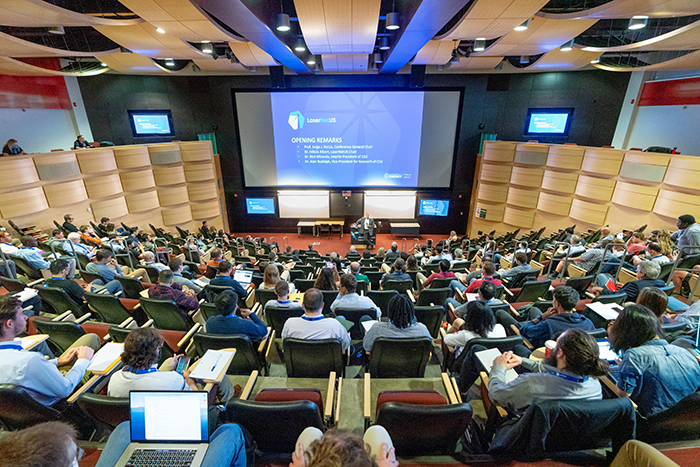
Attendees at the 2022 LaserNetUS Users Meeting gather for opening remarks delivered by Rick Miranda, interim president of Colorado State University, home of the petawatt-class Advanced Laser for Extreme Photonics (ALEPH). Photos by Joe Mendoza/Colorado State University.
The Department of Energy's Office of Fusion Energy Sciences established LaserNetUS in August 2018 as a broad network of university and government laboratory laser facilities to strengthen the nation's position in high-intensity lasers and laser-plasma research.
LaserNetUS first met in 2018 in Lincoln, Nebraska, but subsequent meetings planned for 2020 and 2021 had to be shifted to virtual gatherings due to COVID-19 pandemic restrictions.
This year about 150 people attended, including Nobel Prize for Physics Laureate Donna Strickland, a former LLNL Laser Programs Directorate staff scientist who is a member of the LaserNetUS scientific advisory board. The conference is convened for LaserNetUS members to discuss a wide-range of experiments, simulations, and diagnostic and measurement techniques in the fields of HED and high-intensity laser science.
LLNL physicist Tammy Ma, the Advanced Photon Technologies Program Element leader for High-Intensity Laser HED Science, presented a plenary talk on the role LaserNetUS can play with the currently expanding opportunities in inertial fusion energy (IFE) research.
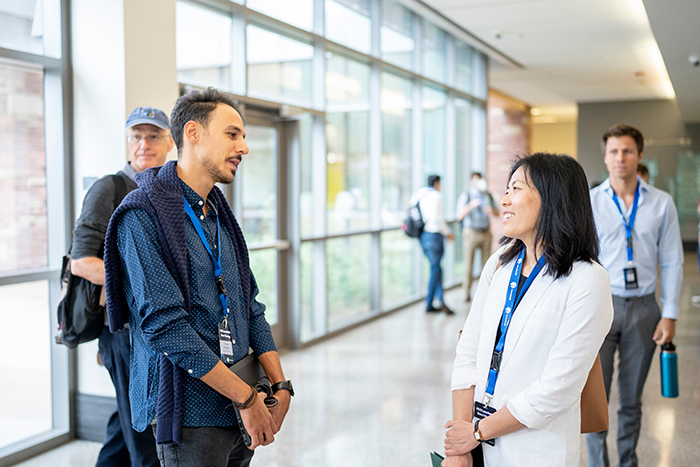
LLNL physicist Tammy Ma (right) chats with LaserNetUS user Ghassan Zeraouli from Colorado State University.
IFE is a top topic for the laser physics community in the wake of NIF's Aug. 8, 2021, experiment that put researchers on the threshold of ignition by producing 1.35 megajoules (MJ) of fusion energy yield. Ma updated the audience on a recent DOE workshop that outlined IFE research opportunities (see "DOE Workshop Examines Inertial Fusion Energy Research Needs").
"The network of ultra-high-power lasers that make up LaserNetUS is a very valuable resource for target physics studies and capability development for IFE," Ma said.
Other plenary speakers were Kramer Akli, program manager for DOE's Office of Science, Fusion Energy Sciences; Sarah Nelson, the National Nuclear Security Administration's acting office director; Allen Weeks, director general of the Extreme Light Infrastructure European Research Infrastructure Consortium; and Howard Milchberg, University of Maryland physics professor.
The meeting was the first chance for members of the organization's user group, the Intense-light Users Engagement Committee (i-USE), to meet in person since being formed to act as a voice of the users and as a liaison with the network's leadership.
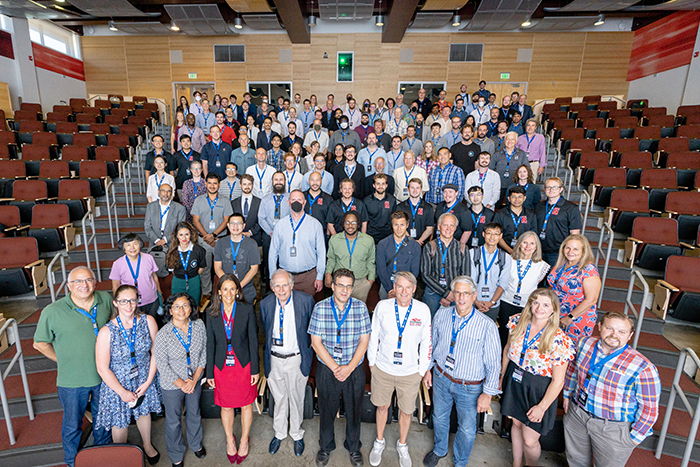
The 2022 LaserNetUS Users Meeting attendees gather at Colorado State University. Sponsors included General Atomics, Focused Energy, lithography systems producer ASML, and Marvel Fusion.
i-USE co-chair Ronnie Shepherd, a senior LLNL researcher, said the meeting provided a “very valuable” opportunity.
“The i-USE group focused on understanding the user's needs, issues, and requests for improvements to make the program more 'scientist friendly,' ” Shepherd said. “We were particularly focused on expanding the user base and helping new users submit proposals. We performed a real-time survey using on-line tools, allowing attendees to respond to questions using their cell phones.”
Those data will be collected and used to make suggestions for improvements to LaserNetUS.
NIF&PS Summer Scholar Adeola Aghedo from Florida A&M University won a best poster award for “Characterization of bremsstrahlung emission from picosecond laser interaction with solids, using front surface target structures.” His mentor this summer was LLNL staff scientist Dean Rusby, who presented an invited talk titled, “Investigation of Proton Acceleration from Compound Parabolic Concentrators.”
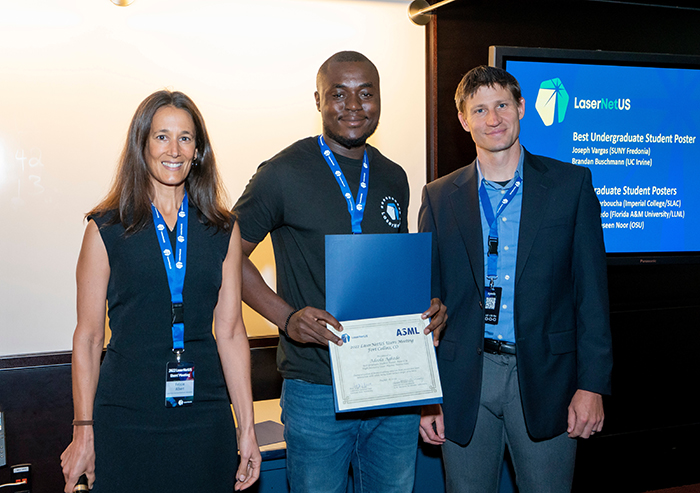
Adeola Aghedo, center, flanked by Félicie Albert and Peter Meyer of ASML, accepts his best poster award.
And Gaia Righi, a Weapons and Complex Integration John S. Foster Jr./Harold Brown postdoctoral fellow working with LLNL physicist Hye-Sook Park, also won a best poster award for her presentation on “Understanding temperature dependence of iron strength at high pressure with ramped compression on Omega EP.”
NIF&PS postdoctoral researcher Kelly Swanson gave an invited talk on the application of machine learning to guide high-repetition-rate, laser-driven particle acceleration experiments.
Posters were also presented by NIF&PS postdoctoral researcher Blagoje Djordjevic, on transfer learning and multi-fidelity modeling of laser-driven particle acceleration, LLNL physicist Jackson Williams, and NIF&PS Summer Scholars Conner Myers and Andre Antoine.
The conference was Albert's last as LaserNetUS chair after leading the group mostly virtually for two years. That included weekly teleconference meetings with the 10 member facilities.
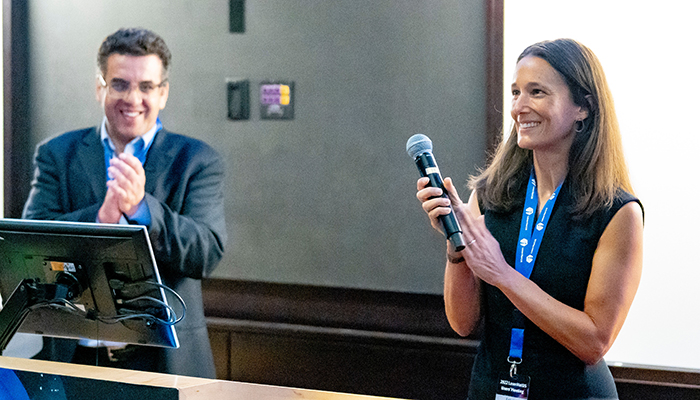
Kramer Akli, program manager for the DOE Office of Science, Fusion Energy Sciences, applauds Félicie Albert for her service as LaserNetUS chair.
“It was a great experience for me,” she said, “because you can see you're building a community, especially for young students and early career scientists who get access to the facilities.”
Ohio State University Physics Professor Douglass Schumacher, who had served as vice chair, took over as LaserNetUS chair, but Albert will continue to be involved with the group.
“We are still a growing community,” Albert said. “There was a lot of work, but we had a really good group of people. It's all about the users; we're here for the users and to help them achieve their great science.”


